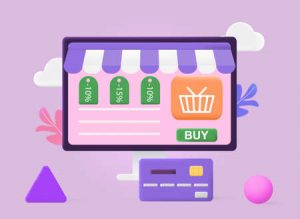The world of direct sales and the birth of SellingAtHome
Jennifer Simon : CEO and co-founder of SellingAtHome
In 2013, Jennifer joined Filiassur, where she worked for 3 years, first in accounting and then in insurance reporting. At the same time, she also worked as a seller for a major home sales company. For almost a year, this was an enriching experience that took her out of her comfort zone. It was during this period that she realized just how cumbersome and time-consuming the seller business processes were: using paper catalogs and manual order forms. It was from this observation that the idea of creating SellingAtHome was born.
It was then that Jennifer and Benjamin decided to develop a solution to digitalize all direct sales processes, for both brands and salespeople. The platform is designed to cover every aspect of the business, from recruitment to team management to paperless order management. For 7 years now, the solution has been constantly evolving, integrating new functionalities to meet the specific needs of brands and salespeople, depending on their sector of activity and technological advances.
Today, we’re talking to Jennifer to find out more about her experience and vision of direct sales.
Discovering direct sales
What motivated you to become a seller ?
“I wasn’t particularly motivated by sales, but rather by the brand. I wouldn’t have accepted to be a seller for another brand because I believed and still believe in the quality of their products. The idea of being able to obtain products by actively participating in sales appealed to me because it was a great opportunity to stock my kitchen while taking on a real challenge. As a non-commercial person, this choice represented for me a great personal challenge, a way of going beyond my limits and discovering a new universe.”
What was your vision of direct sales before you started as a seller ?
“At the time, I had an old-fashioned image of direct sales. I associated it with afternoon teas between housewives, where the social aspect seemed to take precedence over business. I thought that salesmanship was a must, and that the tools available to sellers made the whole sales process very simple and intuitive. I thought everything was perfectly designed to facilitate the work of saleswomen, with ergonomic software and efficient technical support.”
Your experience as a seller
Which aspects were the most interesting and the most difficult?
“The human experience was one of the highlights of my experience. I’ve met a lot of very interesting people, both customers and other seller’s. It’s this relational dimension that gives this job its charm.
At first, I started by selling to people close to me, then my network naturally expanded. The team spirit and management were top-notch, which gave me a great experience despite the challenges.
On a more practical level, the quality of the products made selling easier. On the other hand, the administrative aspects were more cumbersome and tedious. Here are a few examples :
- During meetings, order forms had to be filled out manually, sometimes more than fifteen in a single session. Customers had to complete these by hand, and I had to check each document that evening, then re-enter all the information into an unintuitive back-office by Sunday morning. Given that most meetings were held on Saturday afternoons, this left little time to manage this part of the process.
- Another difficulty was that modern means of payment were not yet available: I had to drop off or send them cheques at the same time as the order forms.
To collect the orders, depending on the size of the order, I had to collect them from Harfleur and sometimes, more rarely, from Rouen.
All these long and tedious processes only added to the arduous aspect of the job.”
Do you think digitalization has made the seller profession more available ?
“Absolutely, digitalization has been a real evolution for this business. Today, the time saved on administration means we can concentrate on selling. Data entry errors are considerably reduced, and online payments have replaced cheques, making everything much more fluid.
What’s more, brands now have real-time visibility of their teams’ performance. This is an advantage for team and inventory management. This modernization has transformed the business, making it more accessible, more enjoyable and more efficient.”
How has your vision of direct sales evolved over the years?
“My experience has completely changed my perception of direct sales. As I’ve already mentioned, I initially had a rather old-fashioned view of this profession. Now I see it as a rewarding opportunity to generate interesting additional income. However, the overload of administrative tasks eventually made me tired, and that’s one of the main reasons why I stopped being a VDI. That said, the evolution of digital tools has modernized this activity, making it simpler today for the administrative part and more attractive for the commercial part.”
Let's talk about the SellingAtHome project

Before getting to the heart of the matter, can you tell us about your current role at SellingAtHome?
Can you tell us about SellingAtHome's history and challenges?
“Initially, I was simply looking for a solution to manage my appointments, address book and sales statistics. Of course, Benjamin saw the bigger picture and developed a platform that directly integrates brand catalogs, purchasing mechanics, inventory management, salesperson management, and so on. It was a major challenge to convince the brands of the effectiveness of our solution and, above all, to prove that this tool could become a central lever in their business. Today, SellingAtHome is a real pillar for many companies.”
What are SellingAtHome's most innovative features?
“For VDIs, the recruitment module and live shopping are real assets, making it easier to run meetings and expand the network.
For brands, the centralized dashboard, recruitment module and data export tools enable more precise management and greater responsiveness.
As a former VDI and current co-founder of SellingAtHome, I think that whatever the needs, SellingatHome responds with efficiency and performance to the different needs and expectations of direct sales players.”
What makes you most proud of SellingAtHome?
“Obviously, my first pride is to have improved the VDI profession and made it more accessible.
I’m also very proud that, as a small French company on a human scale, we’ve managed to convince some major brands to work with us. Today, 7 years later, we work with more than twenty brands who have placed their trust in us, evolving and developing their business thanks to our tool.
I’m proud to be able to say that we create jobs, that we support the launch of small brands by simplifying processes to accelerate their growth and profitability. With this in mind, we have adapted our pricing model: the more sellers a brand activates, the more it contributes, while benefiting from increased profitability. Conversely, in periods of lower activity, costs are reduced, thus avoiding penalizing brands during quieter recruitment phases.”
Looking to the future
What are SellingAtHome's future projects?
“We’re currently working on V2 of the platform, with a visual and technical overhaul. The aim is to stay at the forefront of innovation with modern technologies, while continuing to support brands in their digital transformation.”
What does the future hold for the direct sales sector?
“The direct sales sector needs to adapt to new consumer expectations and integrate more responsible and sustainable practices (CSR). It’s crucial that we no longer regard this profession as a mere hobby, but as an activity in its own right. Moreover, the social dimension will remain essential, as customers need to meet and talk with a salesperson. Covid has reinforced this trend, making direct sales more relevant than ever. Complementarity between different brands will also be a major challenge. VDIs are increasingly offering a variety of products (cosmetics, jewelry, etc.), providing an alternative to traditional large-scale companies.”
The end
A final message for our readers, whether they are seller's, brands or future seller's?
“Go for it! Direct selling has a bright future. Contrary to popular belief, this profession is more modern than ever, with digital tools that simplify everyday life. It’s not an old-fashioned industry, but one that’s in tune with the times … in constant evolution, offering opportunities to all those who want to get started.
For brands, don’t forget to integrate more social responsibility into your business. Here are a few examples :
- Choosing responsible suppliers
- Selling ethical and sustainable products
- Reduce paper and packaging
- Product transparency
- Ensuring fair remuneration
- Providing an inclusive and respectful working environment
Here are a few ideas for you to consider 😉
Discover other articles that might interest you :








